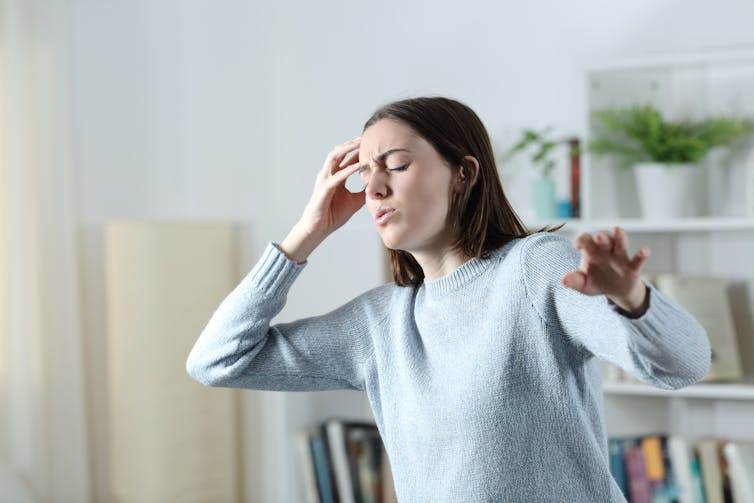
Singer and actress Solange Knowles recently revealed in an Instagram comment that she was diagnosed in 2018 with postural orthostatic tachycardia syndrome (Pots).
In her comment, Knowles acknowledged how struggling with symptoms of Pots can be “debilitating, confusing and lonely”. Many users welcomed the singer and actress speaking out, as the condition is not widely recognised or understood. This lack of recognition often means sufferers are misdiagnosed and can face long waits for care.
Pots is a chronic disorder of the autonomic nervous system. This system controls automatic bodily functions – such as heart rate, blood pressure and breathing.
One of the main features used to diagnose Pots is a rapid increase in heart rate (by at least 30 beats per minute) that happens when a person stands up after sitting or lying down. But this isn’t the only symptom people may experience if they have Pots.
Dizziness, heart palpitations, chest pain and breathlessness, as well as fatigue, headaches, brain fog, bladder and digestive problems are just some of the other symptoms people with Pots may have. These symptoms can occur at any time – not just when a person is standing up from lying down. Symptoms vary depending on the person and can range from mild to severe.
It’s thought Pots affects between 0.2 and 1% of the western population. But prevalence might have increased since the COVID pandemic, as the condition has been linked to long COVID.
Pots is most often diagnosed in young women of reproductive age – with symptoms beginning for most at around the age of 14. Many people diagnosed with the condition also tend to be diagnosed with other health conditions – including migraines, hypermobility (where joints are more flexible than usual), irritable bowel syndrome, chronic fatigue syndrome, fibromyalgia or mast cell activation syndrome. At least 80% of people diagnosed with Pots have one or more of these co-occurring conditions.
What causes Pots?
The medical world is currently uncertain about what causes Pots. Symptoms often develop after a viral infection, vaccination or some form of trauma – such as an accident or traumatic event. But it can also be a side-effect of a joint hypermobility condition – such as Ehlers-Danlos syndrome (a genetic condition that affects the body’s connective tissues).
But while researchers aren’t certain of what triggers Pots, they do understand many of the physiological mechanisms behind the symptoms people experience. For instance, problems such as low blood volume, poor circulatory function in the leg’s veins, dysfunction of the small nerve fibres that control organ systems and abnormal heart rate control are often seen in people with Pots. These mechanisms can all affect the flow of blood and oxygen throughout the cardiovascular system, brain and organs.

Psychological factors, such as worry and stress, can influence Pots symptoms and the way a person copes with them. Experiencing the physical symptoms of Pots can also have a significant psychological impact. Many people with Pots experience increased emotional distress – and the more symptoms a person experiences, the higher their distress tends to be.
Similarly, the worse a person’s symptoms are, the more they may worry about their health. This can mean that sufferers avoid activities that might induce symptoms, then do too much on days when they have fewer symptoms, which could then lead to symptoms getting worse.
What treatments are available?
It’s important to note that Pots is not well-recognised by all medical professionals, and not every healthcare system is familiar with diagnosing and treating the condition. This means it can sometimes take several years after their symptoms first start for a diagnosis to be made.
There are currently no treatments medically licensed to treat Pots specifically anywhere in the world. But, there is a small but growing evidence base of treatments that may help to improve symptoms associated with Pots.
Most treatments that are prescribed are designed to lower heart rate, increase blood volume and improve vein constriction. This improves the function of the cardiovascular system, thus reducing symptoms and improving quality of life. Research also suggests that some prescription drugs commonly prescribed to manage heart problems, blood pressure, hormone issues and muscle weakness can also help manage Pots symptoms.
There’s also evidence that breathing physiotherapy can help with the breathing problems experienced by some Pots sufferers. A gradual build-up of physical rehabilitation and exercise might also be beneficial in improving cardiovascular function and quality of life.
Psychosocial support and behavioural changes are also important, but it can be difficult for people with Pots to have access to this kind of support due to its lack of recognition. For many, it’s difficult to get even treatment in the first place, because of this.
This may partly explain why so many people with Pots self-treat their symptoms – making lifestyle changes such as wearing compression clothing, increasing fluid and salt intake, pacing activity and changing diet and sleep routines. But self-management is often a case of trial and error for each person – and it may take some time before they have put together their personalised tool kit of strategies that work for them.
It can be very challenging to adjust to living with Pots as it often affects all aspects of daily life. This may be why many people diagnosed with the condition often say they miss and grieve for the person they were before they became unwell. For those struggling with the condition, it’s important to be patient with yourself as you learn to navigate your symptoms. It’s also important to know that many different treatments – including lifestyle changes and prescription medication – can help improve function and symptoms after diagnosis.
Nicholas Gall is affiliated with POTS UK, HMSA, medical detection dogs and STARS - all charities in the field. I am a medical adviser and patron of POTS UK
Iris Knoop does not work for, consult, own shares in or receive funding from any company or organisation that would benefit from this article, and has disclosed no relevant affiliations beyond their academic appointment.
This article was originally published on The Conversation. Read the original article.







